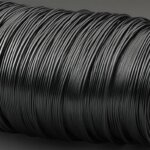Table of Contents
The Contrast to Noise Ratio (CNR) is a measure of the contrast between the tissue of interest and the background in a medical image. It helps in evaluating the quality of the image by considering the contrast in different parts of the image. CNR is closely related to the Signal to Noise Ratio (SNR), which measures the image signal in a given region to the background.
The ability to visualize objects in a noisy background depends on their size and contrast. Image contrast is determined by the different tissue properties measured in medical images. Quantum noise, also known as quantum mottle, is the source of noise in x-ray and CT images, caused by photon counting statistics. The level of quantum mottle can be adjusted by selecting the appropriate radiation dose in order to achieve a balance between noise and visibility of the signal.
SNR and CNR can be calculated based on measurements within specific regions of interest (ROIs) in medical images, providing useful information about image quality.
How is CNR Calculated?
The Carrier-to-Noise Ratio (CNR) is a crucial metric in communications to assess the strength of the received carrier relative to the received noise. The CNR calculation involves determining the power of the carrier signal and dividing it by the total noise power. This ratio is expressed in decibels (dB) and serves as an indicator of reception quality and communication accuracy.
The C/N ratio plays a significant role in digital transmission systems as it directly affects the bit error rates. Higher C/N ratios result in lower bit error rates, ensuring more reliable and accurate data transmission. However, calculating CNR differs from calculating the Signal-to-Noise Ratio (SNR). While SNR is computed prior to digitized modulation, CNR is calculated post-modulation. This distinction arises from the use of carrier signals in digital modulation methods such as amplitude-shift keying, frequency-shift keying, phase-shift keying, and quadrature amplitude modulation.
CNR measurements are commonly used in satellite communications systems and point-to-point microwave shots to evaluate noise levels. A higher C/N ratio indicates better signal alignment and higher reception quality, leading to improved communication performance.
Example Calculation of CNR
To illustrate how CNR is calculated, let’s consider a hypothetical scenario:
| Parameter | Value |
|---|---|
| Power of the carrier signal (Pcarrier) | 10 dBm |
| Total noise power (Pnoise) | 5 dBm |
To calculate CNR:
- Convert the power values to linear scale using the formula: power (linear) = 10(power (dB)/10)
- Calculate the carrier-to-noise ratio using the formula: CNR = 10 * log10(Pcarrier/Pnoise)
In the given example, the CNR can be calculated as:
CNR = 10 * log10((101) / (100.5))
CNR ≈ 10 * log10(10.0)
CNR ≈ 10 * 1.0 = 10 dB
The calculated CNR value of 10 dB indicates a strong carrier signal relative to the noise, suggesting good reception quality and accurate communication.
CNR Analysis in X-ray Imaging
Contrast-to-Noise Ratio (CNR) analysis plays a crucial role in evaluating the quality of X-ray images. By assessing contrast resolution, CNR analysis enables the control and comparison of image quality across different modalities. It also provides a quantitative measure to evaluate the detectability of lesions or defects in X-ray images, thereby aiding in accurate diagnosis and treatment planning.
X-ray imaging devices, particularly flat panel detector radiography systems, are used for CNR analysis. During the evaluation process, the X-ray tube voltage and tube-detector distance are set to maintain consistent imaging conditions. To obtain phantom images with varying exposure conditions, the X-ray tube current is adjusted. These phantom images are processed and converted into a standard DICOM/XBit file format for CNR analysis.
Similar to Signal-to-Noise Ratio (SNR), CNR values are calculated based on defined regions of interest (ROIs) within the exposed image. By optimizing radiation doses and improving the visibility of objects in radiographic images, CNR measurements enhance lesion detectability. This is particularly valuable when detecting subtle defects against uniform backgrounds.
To provide a visual representation, consider the following table:
| Image Analysis Software | Features |
|---|---|
| VIDISCO VEO Pro | Provides precise CNR and SNR measurements |
CNR and SNR measurements can be performed using image analysis software such as VIDISCO VEO Pro. This software enables the definition of a region of interest (ROI) on the exposed image, allowing for the calculation of SNR and CNR values. The measurements facilitate image quality control and enable accurate evaluations of local contrast and signal visibility.
Overall, CNR analysis plays a vital role in enhancing image quality, optimizing radiation dosage, and improving lesion detectability in X-ray imaging. By leveraging this method, healthcare professionals can ensure accurate diagnoses and provide effective treatment plans for patients.
CNR and SNR Measurements in Practice
CNR and SNR measurements play a crucial role in image quality control and signal strength assessment. These measurements are performed using advanced image analysis software, such as VIDISCO VEO Pro, which provides accurate and precise results.
To obtain CNR measurements, a defined region of interest (ROI) is selected on the exposed image. The image analysis software then analyzes the ROI and generates parameters and statistics, including average signal, noise, and standard deviation. These values are used to calculate the CNR, allowing for a quantitative assessment of the contrast and noise levels in the image.
In the case of SNR measurements, the software requires the definition of the ROI and the image polarity. By utilizing this information, the software can calculate the normalized SNR based on the spatial resolution detected. This facilitates a thorough evaluation of the signal strength and its visibility in the image.
Precise CNR and SNR measurements obtained through image analysis software significantly enhance image quality control processes. They enable medical professionals to accurately evaluate the local contrast, noise levels, and signal visibility in medical images. By utilizing these measurements, healthcare providers can ensure the delivery of high-quality diagnostic images, leading to more accurate diagnoses and improved patient care.
FAQ
What is Contrast-to-Noise Ratio (CNR)?
The Contrast-to-Noise Ratio (CNR) is a measure of the contrast between the tissue of interest and the background in a medical image. It helps evaluate the quality of the image by considering the contrast in different parts of the image.
How is CNR Calculated in Communications?
The Carrier-to-Noise Ratio (CNR) is a measure of the received carrier strength relative to the strength of the received noise in communications. It is calculated as the power in the carrier of the desired signal divided by the total received noise power.
How is CNR Used in X-ray Imaging?
CNR analysis is a method of evaluating contrast resolution in X-ray images. It is commonly used to assess image quality, control image quality, compare modalities, and quantitatively evaluate the detectability of lesions or defects.
How are CNR and SNR Measured in Practice?
CNR and SNR measurements are performed using image analysis software, such as VIDISCO VEO Pro. A region of interest (ROI) is defined on the exposed image, and the software provides parameters and statistics for each ROI, including average signal, noise, and standard deviation. These measurements allow for the calculation of SNR and CNR values.













